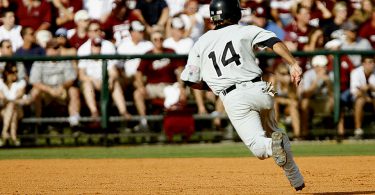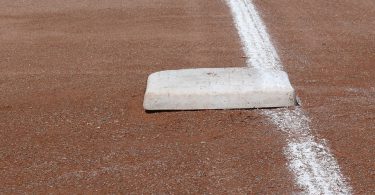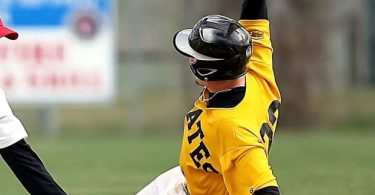The Situation:
There’s a runner at first with 2 outs in the bottom of the 9th inning of a win-or-go-home playoff game. The game is tied and the offense has some momentum with a speedy runner on first base. The left-handed hitter steps in to face the right-handed reliever.
The Play:
The pitcher comes set for a one-count, lifts his leg up high, and delivers. The runner at first gets a good jump and the pitcher’s delivery to the plate is slow. By the time he has released the ball, the runner at first is 7 steps towards second and the stolen base is a foregone conclusion. What is unexpected is the batter lays a bunt down the third base line. It’s well placed and the pitcher charges directly towards the line and fields it on the backhand. As he plants to make the difficult throw, his back leg slips and his feet are tangled.
The Outcome:
The play at first is very close, but the ball runs arm side and into the runner. The right-handed first baseman is standing high, facing the third base line, with his left foot on the base, and right foot in line with second base. As the throw veers towards the runner, he tries to stretch with his right foot extended to the ball and hold the bag with his left foot. He is able to glove the ball, but as he does, his glove makes contact with the batter and the ball is knocked loose. It goes flying down the line. The second baseman doesn’t see the ball come loose and has stopped his route to back up the play and despite the right fielder hustling to backing up, the ball rolls down the line far away from all fielders. The stealing runner never stops and circles all the way home. He scores without drawing a throw for the walk-off win.
What Went Wrong:
This play is one big #ThinkTheGame situation and there are lots of things that go wrong for the defense. We’ll break it down by position.
The Pitcher:
Anytime a right-handed pitcher delivers the ball home in any time over 1.3 seconds, he’s asking for trouble. With 2 outs, the attention should be on the hitter, but holding runners with the winning run on base is a must. You simply can’t afford to give the base runner an easy pass into scoring position where he is an error or a bloop away from winning the game. You take care of this problem by training from the stretch at a 1.3 or less. When you train at a 1.3 or less, you no longer have to rush or do anything different in high pressure situations, you simply do what you do. The second mistake by the pitcher is forcing a throw while slipping on what is already a difficult play. You would obviously rather be out of the inning, but you can’t bet the season on making a low-percentage throw while off balance. You can live with runners at 1st and 2nd, 2 outs. It’s not optimal, but the game continues. No way around it, this is a tough pill to swallow.
The First Baseman:
On bunt plays where the first baseman is receiving a throw from the third base line, it’s difficult to set up because you can’t straddle the bag and must give the runner a piece of the base. His alignment is okay, but he errs by standing upright on a play that requires tricky footwork. When he is required to make a quick move to the ball, he doesn’t have time to stretch with the correct (left) foot, which will allow him to maximize his stretch up the line and hopefully cut the throw off before it gets to the runner. When he stretches to the ball with his right foot, he cuts off his range because a full stretch would cause him to have his back turned to the ball and have to awkwardly reach for the ball across his body. It’s the exact reason why first baseman stretch with their glove foot. Making this play can be practiced by placing a dummy a stride or two from the bag during infield practice and forcing the first baseman to work around it to handle the throw up the line.
The Second Baseman:
The second baseman is a key line of defense here for backing up. He must sprint to get to an appropriate backup position, deep behind the first baseman where the dirt and grass meet. This will likely require an all-out sprint to get there. You don’t want to get caught spectating or watching the play develop. You want to be where the ball will be if there are any mistakes and make sure that you will be moving in towards the ball to have a shot at the lead runner wheeling around.
Overall, this play epitomizes a high-pressure baseball play and emphasizes the need to train at game speed and be able to think the game!







